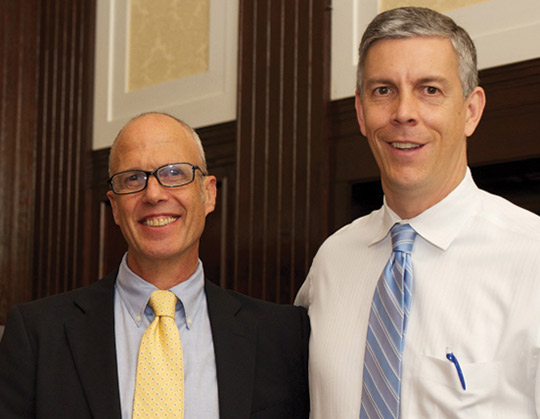Taking Student Health to Scale
Last year, when Colorado began offering a new public school program that enables kids to grab breakfast off a lobby cart and chow down during their first-period classes, some teachers and administrators raised concerns.
Last year, when Colorado began offering a new public school program that enables kids to grab breakfast off a lobby cart and chow down during their first-period classes, some teachers and administrators raised concerns.
True, schools have been offering free breakfast for years in their cafeterias, prior to the first bell. But wouldn’t eating in class be a major distraction? What about the mess?
The fact is, breakfast programs nationwide are significantly underused because parents have difficulty getting their kids to school early, and also because, for many older students in particular, there is a stigma about eating “charity food.”
To the state’s administrators, though, there was a bigger reason for making the change: Eating breakfast can help improve academic outcomes.
“Neuroscience research has identified the processes by which dietary behavior influences neuronal activity and synaptic plasticity, both of which influence cognitive functions,” writes Charles Basch, Teachers College’s Richard March Hoe Professor of Health and Education.
To Basch, who gave the keynote address at Colorado’s annual statewide education summit last spring, insufficient breakfast is just one facet of a much more complex and challenging problem: the inferior health status and health care received by many low-income and minority children in the United States. In 2010, in work originally commissioned by TC’s Campaign for Educational Equity, Basch documented the scope of these “educationally relevant health disparities” in a meta-analysis that filled an entire issue of the Journal of School Health. Incorporating information from hundreds of previous studies by other researchers, he showed unequivocally that poorer students suffer disproportionately from a group of interrelated health problems – poor vision, asthma, teen pregnancy, aggression and violence, inadequate physical activity, insufficient breakfast, and inattention and hyperactivity – that directly hinder their achievement in school. The publication included a preface by one of Basch’s former students at TC, Howell Wechsler, Director of the Division of Adolescent Health at the U.S. Centers for Disease Control. Wechsler wrote that “the articles by Basch…represent the most comprehensive, authoritative, and compelling summary of why addressing health-related barriers to learning needs to be a fundamental component of school reform efforts.”
Perhaps just as important, Basch called attention to precisely how and why each health issue affects school performance. For example, he reiterated findings that a sense of “school connectedness” fosters a desire to achieve. He also cited evidence that exercise stimulates the production of brain-derived growth hormones, oxygen saturation and other chemical reactions in the brain that that facilitate learning.
“If you can’t see, if you’re not getting a good night’s sleep because you can’t breathe, if you’re not thinking clearly because you haven’t eaten breakfast or if you’re afraid to come to school because you live in fear of getting hassled and bullied, there’s no way you’re going to be able to learn, and certainly not at the level of other students who don’t face these issues,” Basch said recently in his office in TC’s Thorndike Hall. He is a lean, intense man who talks rapidly when he gets on the topic that has occupied most of his time for the past several years. “Eighty to ninety percent of school turn-around efforts have failed, and I believe that a big reason is that we haven’t addressed these health barriers. Until we do, our efforts to close the nation’s achievement gap by academic means – improving teacher and leader effectiveness, improving curriculum, strengthening learning standards and assessment – are going to be greatly compromised.”
Similar positions have been endorsed by organizations such as the National Education Association, the American Association of School Administrators, the American Association of State Boards of Education, the American School Boards Association and the Association for Supervision and Curriculum Development. Since publishing his report, Basch has been sharing his findings and proposals with audiences across the country, ranging from U.S. Secretary of Education Arne Duncan and state and city education commissioners, to advocacy group leaders, representatives of private foundations, school boards, teachers, parents and concerned citizens.
“What’s needed now is to put into practice what we know in a way that is scalable to reach thousands of schools – especially the 5,000 lowest-performing schools in the nation,” he says.
Working closely with the Chicago-based Healthy Schools Campaign, Basch has framed a blueprint for change that would put schools themselves at the center of a coordinated network of players – parents, teachers, state and city agencies, schools of education – all focused on student health. “What I’m proposing is going to require a real social change in the way we think of the mission of schools, and in the connections among schools, communities and families,” he says. “Schools have resisted taking on health problems as part of their fundamental goals in the past because they haven’t seen that as their primary mission. But they’ll be much more receptive if they realize that focusing on health can have a substantive impact on educational outcomes, and that failure to do so will jeopardize their other educational efforts.”
Stephanie Wasserman, who directs health and wellness initiatives for the Colorado Legacy Foundation, a nonprofit that works closely with the public schools, agrees with that assessment.
“Chuck Basch is really flipping the traditional school health model on its head,” Wasserman says. “There have been many school-based attempts to improve students’ health, but they haven’t been very connected with academic outcomes. Chuck’s approach makes it very clear why educators should care.”
Basch himself is partnering with the New York City Department of Education and New York City Department of Health to seek funding to test his approach in nearly 60 of New York City’s lowest-performing elementary schools. His team at TC consists of his longtime colleagues Randi Wolf, Professor of Nutrition and Education, and Patricia Zybert, a research scientist and statistician in the Department of Health and Behavior Studies. Other TC faculty in his group include Eric Nadelstern, Professor of Practice and former Deputy Chancellor of New York City’s public schools; Michael Rebell, an expert on comprehensive services for students from poverty backgrounds and school finance; Henry Levin, the noted education economist; Aaron Pallas, an authority on standardized testing; Lucy Calkins, the literacy guru who is founding Director of the TC Reading and Writing Project; and Ernest Morrell, a nationally recognized English educator who directs the College’s Institute for Urban and Minority Education. Their goal is to compare the standardized test scores (and mediators, including school attendance and school connectedness) of students in schools receiving Basch’s intervention with those in a control group of schools that did not.
Meanwhile, a number of states and districts, including Tennessee, Ohio, Idaho, Colorado and the Boston and Denver public schools, are instituting all or parts of Basch’s proposal on their own.
The Basch model has three major components.
First, it targets health issues that are prevalent and disproportionately affect low-income and minority youth, have a direct impact on educational outcomes, and can be effectively addressed through school health programs.
Second, the Basch model uses a group of proven, evidence-based programs that have improved health and educational outcomes for thousands and sometimes millions of students, but which have never been collectively evaluated for their impact on academic performance. These programs include Breakfast in the Classroom; Vision for Success, a program designed by Basch and a former doctoral student, Danna Ethan, together with New York City health officials, which has doubled the in-class use of eyeglasses; and Open Airways in Schools, an asthma education program developed by the American Lung Association, which aims to reduce poorly controlled asthma and improve school attendance. Other initiatives recommended by Basch focus on improving students’ social and emotional skills, decreasing behavioral problems and building character, and increasing in-class physical activity.
Third, the Basch model applies a “scaling mechanism” for implementing all of these programs together. The scaling mechanism consists of a full-time school health coordinator position in each school, professional development for teachers and school personnel, and roving coaches who would provide assistance to teachers, staff and administrators. Along perhaps with an assistant principal for school health, these new positions ultimately would become the focus of a new professional track developed by schools of education.
“Chuck’s proposal is the only one I’ve ever seen that presents a comprehensive approach to student wellness, from nutrition to health screening to behavioral modification to classroom performance,” Nadelstern says. “Other efforts have used aspects of this, but he’s saying, ‘If we can have resources and incentivize all the schools to focus on all of these issues, we can have a profound impact.’ And I think he’s right.”
Many other education leaders agree.
“We started work on our strategic plan in 2010 using Chuck’s article to set the tone and reference why we were choosing to focus on certain priorities,” says Jill Carter, Executive Director of the Boston Public Schools (BPS) Health and Wellness Department. Basch was the keynote speaker in December 2011, when BPS Superintendent Carol Johnson, who has made improving student wellness a critical part of her Academic Acceleration Agenda, presented the plan to city officials.
The BPS plan incorporates all the key features that Basch recommends. These include a physical activity program that incorporates in-class movement breaks, physical education and even staff wellness; an in-class breakfast program; and a vision program that issues two pairs of glasses to each qualifying student. Carter and her team recently received grants that will enable them to launch a pregnancy prevention program in middle schools.
“The idea of coordinated school health has been around for 25 years, and we were working on a lot of these issues before Chuck published his paper,” Carter says. “But part of what he’s done is to provide the data analysis to support the idea that all of this really matters. It’s hard to be an expert in your own district, but if someone from Teachers College is saying it, and it’s in the news – well, it must be good, because they’re talking about it.”
In Ohio, Basch’s ideas constitute the foundation of a pilot partnership between the State Department of Health and the State Department of Education to improve student health and school performance.
“Chuck’s article came out at a perfect time for us,” says Laura Rooney, Adolescent Health Program Manager in Ohio’s Department of Health. “We had received funding for coordinated school health from the U.S. Centers for Disease Control and Prevention and were trying to link health outcomes to school improvement, and his work does precisely that.
“As Ohio is restructuring school report cards and teacher accountability, we wanted to find a mechanism that supports the district’s ability to look at the whole child for student success and go beyond test scores and curriculum.”
Ohio schools placed on academic watch or academic emergency status are recruited to participate in a Healthy Schools Leadership Institute that helps them to identify health measures that can aid students.
“We ask schools to look at their students’ behavior and health outcomes, and then to line those up with overall school performance, so that they are the ones making inferences,” Rooney explains. “Then, they look at their policies and practices to see which ones are supporting student health and which ones are impeding it. How are they taking attendance? Do they know why students are absent? Can they get that information? If a lot of their kids have diabetes, do they know whether absences are occurring because of that? And if so, are there interventions they could put in place? Ultimately, each school writes a change plan that reflects an analysis of their policies, practices, leadership initiatives and school climate.”
In a final step, the schools link their change strategies to their districts’ overall school improvement plan, “so that health measures are not looked at as being separate from school performance,” Rooney says.
Basch emphasized this last point during a meeting with Arne Duncan last spring. The meeting was arranged by Rochelle Davis of the Healthy Schools Campaign, and it included Davis, Basch and the leaders of the W.K. Kellogg Foundation and the Chicago Community Trust. Basch had just a few minutes to summarize his plan, and when Duncan asked why many features of it weren’t already happening in schools, he had an answer ready.
“I said, ‘Because we need the education goals of the nation to recognize the importance of addressing educationally relevant health problems, especially for youth living in poverty,’” Basch recalls. “ ‘We need changes in accountability structures to ultimately promote change. Because if schools aren’t held accountable for it, if no one’s measuring it, then it’s not important.’”
Basch, along with Davis and the meeting’s other attendees, urged Duncan to empower an Office of Safe and Healthy Students, run by a Deputy Assistant Secretary of Education, to provide strategic leadership to fully integrate health and wellness into the Department’s policy and practice. They also recommended that student health criteria be incorporated into the federal government’s various professional development and human capital programs for schools, such as Investing in Innovation, School Improvement Grants and Blue Ribbon Schools.
In a subsequent speech, delivered early in May at the National Press Club in Washington, D.C., Duncan spoke about the importance of school health and vowed to promote change.
“I think [Duncan] gets it. But the U.S. is unique in having such a decentralized education system,” Basch says. “The government is incredibly influential, but it also has limitations. And the politics are intense.”
Indeed, politics are a major reason why Basch, who is no great fan of standardized testing, has made a dramatic improvement in standardized test scores the key endpoint of his proposed study. It may be, as his TC colleague Michael Rebell suggests, that comprehensive school health could appeal to Republicans as well as Democrats because it all comes down to getting more bang for the taxpayers’ buck and using existing resources more wisely. As another colleague, Aaron Pallas, puts it, “this is one of those ideas that’s so obvious that you wonder why it hasn’t been tried before.”
Right now, though, state legislatures are strapped for cash, and only the most dramatic kind of evidence is going to convince them to embrace a change of this magnitude. To that end, Basch is betting that the lowest-achieving New York City elementary schools would achieve increases of 20 scale points (versus a 10-point increase in controls) on both English language arts and mathematics standardized tests, raising the percent of students proficient at grade level from 34 percent to 68 percent in the former and from 42 percent to 70 percent in the latter.
“Test scores alone are clearly an imperfect metric for judging the extent to which schools are succeeding, but that’s the metric widely used in states as well as nationally,” Basch says. “For many people, parents included, improving problems like children’s vision, school connectedness and absenteeism are worthy goals in themselves. Nevertheless, this work won’t convince thousands of school leaders to adopt school health as a fundamental mission of their schools if we can’t influence academic achievement. But if we do succeed, it will be judged revolutionary and could create a transformative change in the ways we educate the next generation of Americans.”
In Colorado, it’s still far too early to know whether Basch’s proposed reforms will achieve that kind of impact. But in October, Wasserman of the Legacy Foundation reported hearing from teachers that, since the launch of the new school breakfast program, “kids are way more focused.
“In Boulder, one kindergarten teacher told us that she has a little girl in her class who had never spoken,” Wasserman says. “When they began serving breakfast, she spoke for the first time.”
Published Friday, Dec. 7, 2012


